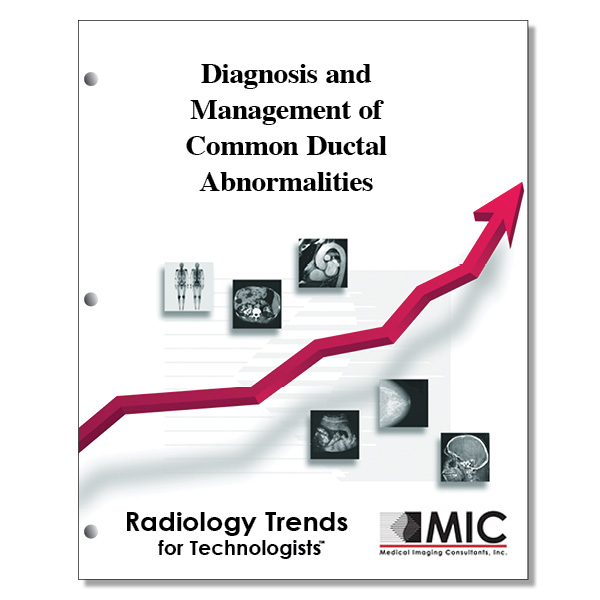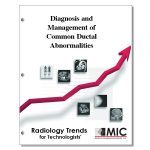

Diagnosis and Management of Common Ductal Abnormalities
Ductal anatomy is reviewed, imaging and biopsy methods are discussed, and benign and malignant conditions associated with the ductal system are presented.
Course ID: Q00357 Category: Radiology Trends for Technologists Modalities: Mammography, MRI, Sonography3.25 |
Satisfaction Guarantee |
$34.00
- Targeted CE
- Outline
- Objectives
Targeted CE per ARRT’s Discipline, Category, and Subcategory classification:
Breast Sonography: 3.25
Patient Care: 1.50
Patient Interactions and Management: 1.50
Procedures: 1.75
Anatomy and Physiology: 0.75
Pathology: 1.00
Mammography: 3.25
Procedures: 3.25
Anatomy, Physiology, and Pathology: 1.75
Mammographic Positioning, Special Needs, and Imaging Procedures: 1.50
Magnetic Resonance Imaging: 3.25
Patient Care: 1.50
Patient Interactions and Management: 1.50
Procedures: 1.75
Body: 1.75
Registered Radiologist Assistant: 3.25
Procedures: 3.25
Thoracic Section: 3.25
Sonography: 3.25
Patient Care: 1.50
Patient Interactions and Management: 1.50
Procedures: 1.75
Superficial Structures and Other Sonographic Procedures: 1.75
Radiation Therapy: 3.25
Patient Care: 1.50
Patient and Medical Record Management: 1.50
Procedures: 1.75
Treatment Sites and Tumors: 1.75
Outline
- Introduction
- Ductal Anatomy
- Imaging Evaluation
- Galactography
- Untrasonography
- MR Imaging
- Biopsy Methods and Technical Issues Specific to Sampling of Ductal Abnormalities
- Benign Diseases
- Duct Ectasia
- Blocked Ducts
- Inflammatory Infiltrates
- Periductal Mastitis
- Apocrine Metaplasia
- Papillomas
- Papillomatosis
- Malignant Diseases
- Ductal Carcinoma in Situ
- Invasive Ductal Carcinoma
- Paget Disease
- Conclusions
Objectives
Upon completion of this course, students will:
- identify the advantage of vacuum-assisted biopsy
- identify benign lesions of the ducts
- know the importance of the basement membrane
- describe nonspontaneous discharge
- be familiar with physiologic nipple discharge
- evaluate the need for follow-up to spontaneous nipple discharge
- identify the TDLU anatomy
- discuss the function of myoepithelial cells
- discuss the anatomy of Cooper’s ligaments
- understand the use of galactography
- discuss the termination of the galactogram procedure
- discuss the amount of compression used in galactography
- be familiar with the normal appearance of the ducts on US
- identify the variability in the ducts due to the lactational state of the patient
- identify the cause of high intensity signal on MR imaging
- discuss the difficulty of MR guided breast biopsy of the retroareolar region
- discuss the use of site markers after vacuum assisted biopsy
- define ductal ectasia
- understand the relevance of peripherally located ectasia
- discuss the evolution of blocked ducts into mastitis
- know the organisms involved in lactation associated infections
- know the methods of symptom relief for blocked ducts
- identify the characteristics of lesions caused by inflammatory infiltrates
- be familiar with risks factors for periductal mastitis
- know the characteristics of apocrine metaplasia
- discuss how apocrine metaplasia is demonstrated on glactography
- explain how cysts are formed in apocrine metaplasia
- identify the characteristics of benign solitary papillomas
- explain the characteristics of papillomas on color Doppler ultrasound
- discuss the characteristic of papillomas on MR imaging
- compare the risk of breast cancer of patients with papillomatosis to average women
- identify the origin of DCIS
- discuss the appearance of microcalcifications in DCIS
- know the appearance of invasive ductal cancer on mammography
- identify the biopsy technique needed if an invasive cancer is cystic in nature
- list the three main categories of primary invasive breast cancer
- identify the specific malignant characteristics of invasive ductal carcinoma on US
- know the surgical procedures that most patient with Paget disease undergo
- discuss how Paget disease is diagnosed
- identify the symptoms of Paget disease
